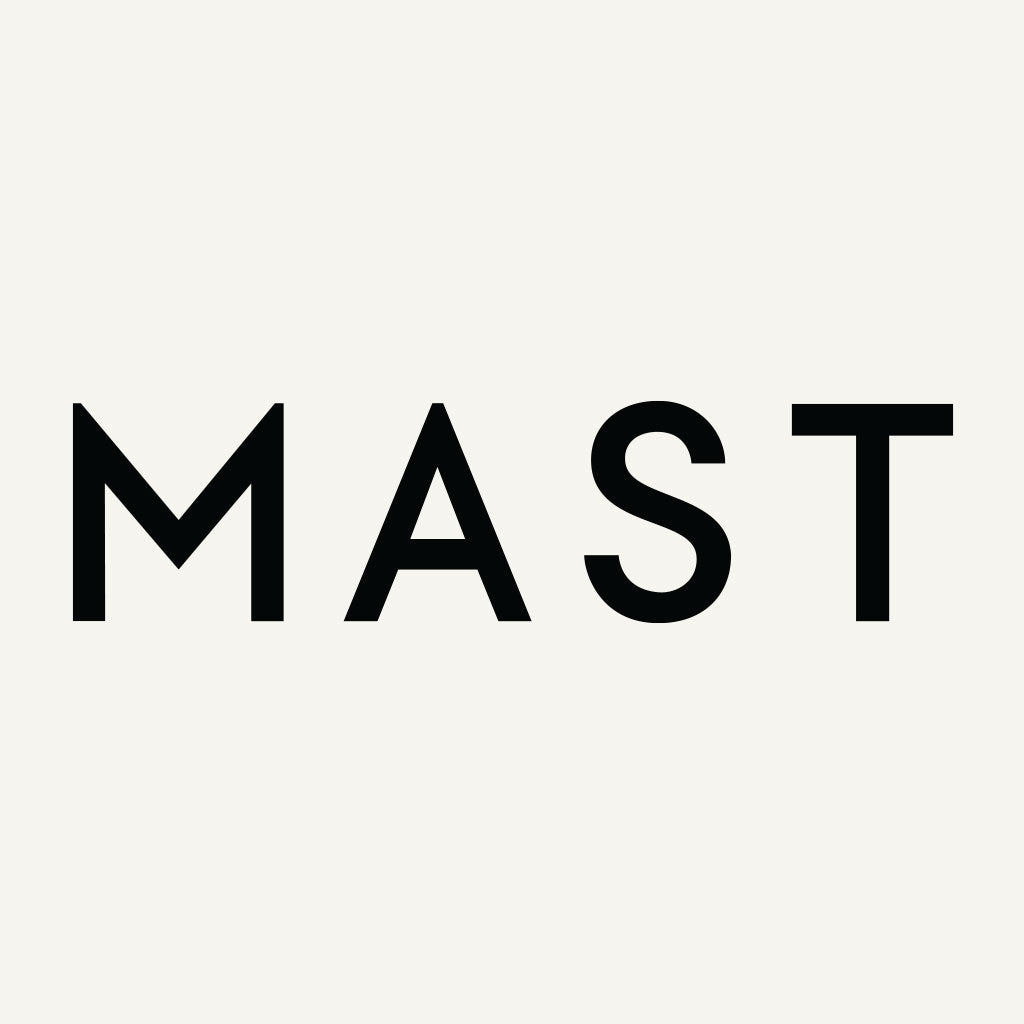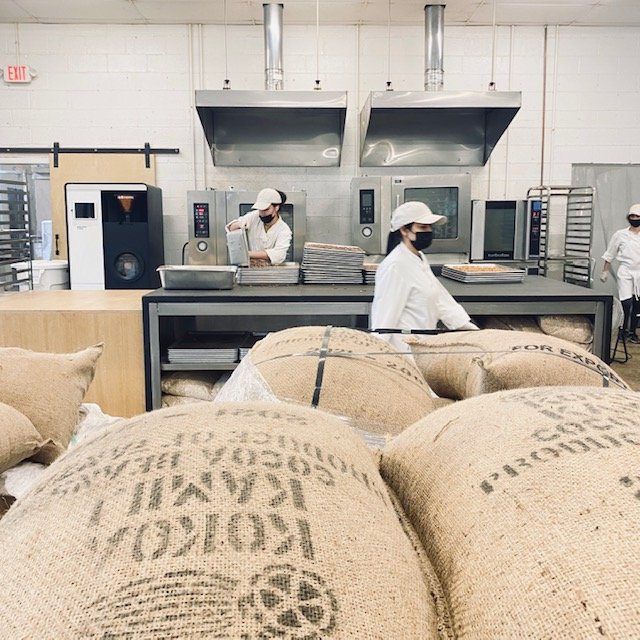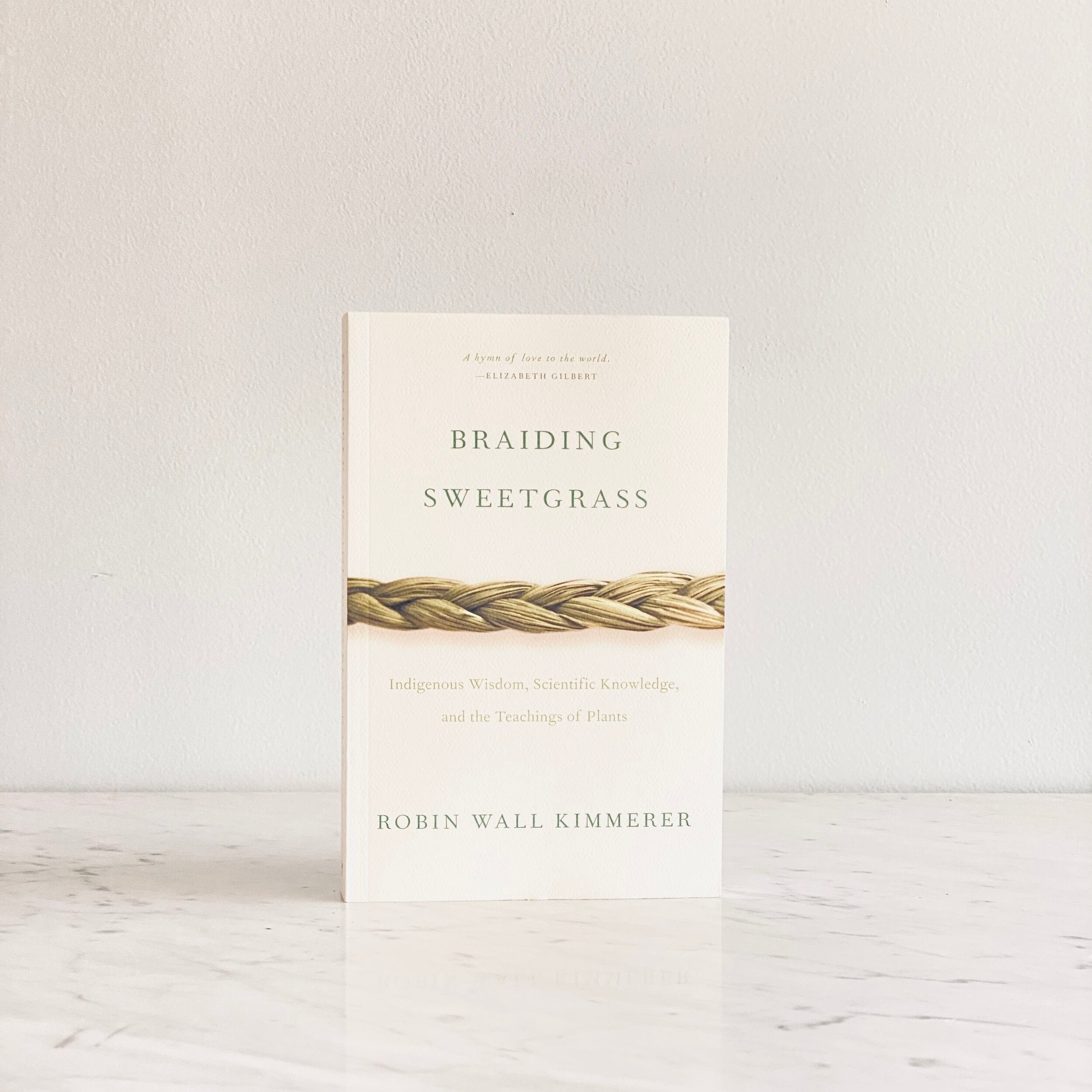True Originals
Whether in character or craft, some people are simply true originals. Artist and ceramicist Eric Bonnin is, without doubt, one of these types. His style, form, texture, and restraint are some of the most imitated and admired, and we are lucky to have been working with him for so long and to be able to offer so many of his ceramic pieces in our market.
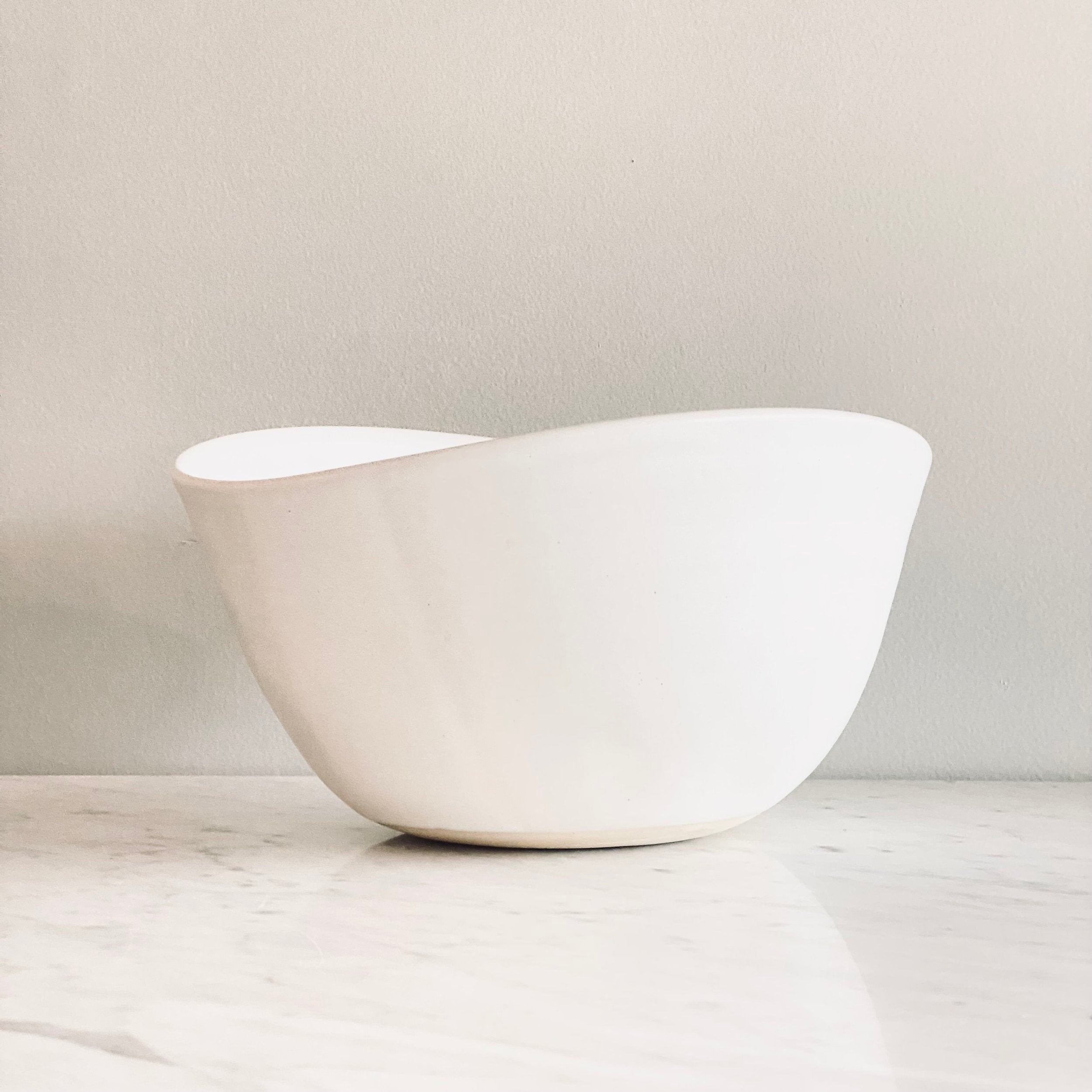
Kam stacking bowl by Eric Bonnin.
Mast was first introduced to Eric's work at our favorite ceramics shop in Brooklyn: Mociun, about a decade ago or more. His work stood out to us for its organic simplicity, materiality, and sculptural whimsy. His work was just beautiful and we found ourselves drawn to it immediately, just wanting to hold the pieces and imagining having them a part of our daily lives.
We called him shortly after that visit to set up a meeting and commissioned him to make us cake stands, bowls to display our hand rolled truffles and trays to offer samples. We also commissioned him to make us ceramic cups for a limited run of candles with local candle makers, Joya. Every time he delivered the commissioned pieces it took our breath away. The sculptural simplicity and imagination brought to each project was equal parts surprising and timeless. Better yet, working with Eric means working with one of the nicest, sweetest, most modest people you'll ever meet. He clearly loves his work, and this love is reflected in every piece he throws.
It was a delight to sit down with Eric and talk about his journey to pottery, where he finds inspiration, and the joy he still gets from his work, day in and day out.
Mast Journal: Did you have a creative upbringing as a child? What were you interested in growing up?
Eric: My mom was very creative. She ran sewing classes, knitting classes, anything to do with thread. And my grandmother was a seamstress so it ran in the family. So when I was a kid, I was making clothes for my little dolls [laughs]. I always liked to create small models of houses, so I thought I could be in the architectural world. But after that, life went on and I studied chemistry which was completely different. Then, I decided to go back to the creative world and I went into a graphic design and advertising program which was fun, but it was also the eighties so advertising was everywhere. I didn’t want to be at a big firm, and one of my teachers actually took me to an opening which was created by the French Ministry of Culture, and they were promoting French furniture design. I thought, “This is where I want to work.” So when I finished my courses, I got hired to do PR and promote other creative peoples’ work, which was very exciting and I learned a lot, but I didn’t do anything creative for many years. It was still fun to be part of that world though, because it was the mid-late eighties and everything was booming in France.
Mast Journal: So how did you discover pottery?
Eric: I had done pottery when I was a child in school. My mom still has pieces that I made and I always go, ‘You should throw those in the trash! They’re terrible.’ But when I came to New York, I couldn’t work for a period of time because of my green card. One of my roommates was working as an artist and was doing a project for MTV where he was redoing their conference room. The table was made of three dimensional tile. So I spent a lot of time in his studio and helped paint all those pieces, and it was all about American pop culture so it was really fun. I found that I really enjoyed working with clay, and I started to do a few little things on my own. Then, I met Jonathan Adler who was a friend of a friend and I started to work with him painting some pieces, and I saw him throwing and I thought, ‘This is awesome. I want to do that.’ So I took classes, and I was at the YWCA and I became an assistant and eventually taught there, and it was always just a hobby until 2008 when the financial crisis happened. I’d been working in furniture and I thought, ‘Maybe I should try something new.’ They always say during crises that you should try to reinvent yourself, so I gave myself six months. I created a line of functional pieces and took a booth at the Javits Center, and it got really good responses. I got a small article in the NY Times, I got a few orders from different stores, and since then I’ve been a full-time potter.
Mast Journal: When did you come to New York and what drew you there?
Eric: In the early-mid nineties, Paris was very nice and it still is nice. But it was kind of a Sleeping Beauty. I came to New York to take an English class, and I got there and everything was possible. There were run-down buildings, but it was fun and I lived in a big loft in SoHo. It was just so much more exciting than Paris. I was here for three months, then I went back to Paris, and then I came back and met my boyfriend and we’ve been together for almost thirty years now. But New York was just very different. It’s also always easier to be yourself in a different place where nobody knows you. Also, I was a bit exotic because I was French [laughs].
Mast Journal: You mentioned that you worked in furniture. How do you think your experience in furniture influences your pottery?
Eric: When I started to make pottery, I loved the medium but when I was looking around at other work, what I would see was very rustic and not modern. It was mostly seventies pottery styles like macramé and brown glazes, and I wanted to bring something more personal and more modern to it. So my background in furniture helped me define a style by looking at old designs from the sixties and fifties from Scandinavia and France, and I wanted to inject some modernity into them. Also, I was lucky enough to have won a little prize which was a trip to Japan, and I learned about their use of black clay which was very nice. When I came back and tried to look for it, I couldn’t quite find the same kind but I found this dark brown clay that I’ve been using ever since. So my background in furniture helped me to see volumes and to see three dimensionally rather than just the object you throw on the wheel without thinking about it. I also saw the whole thing as a line and not just a few projects. I really tried to create a world.
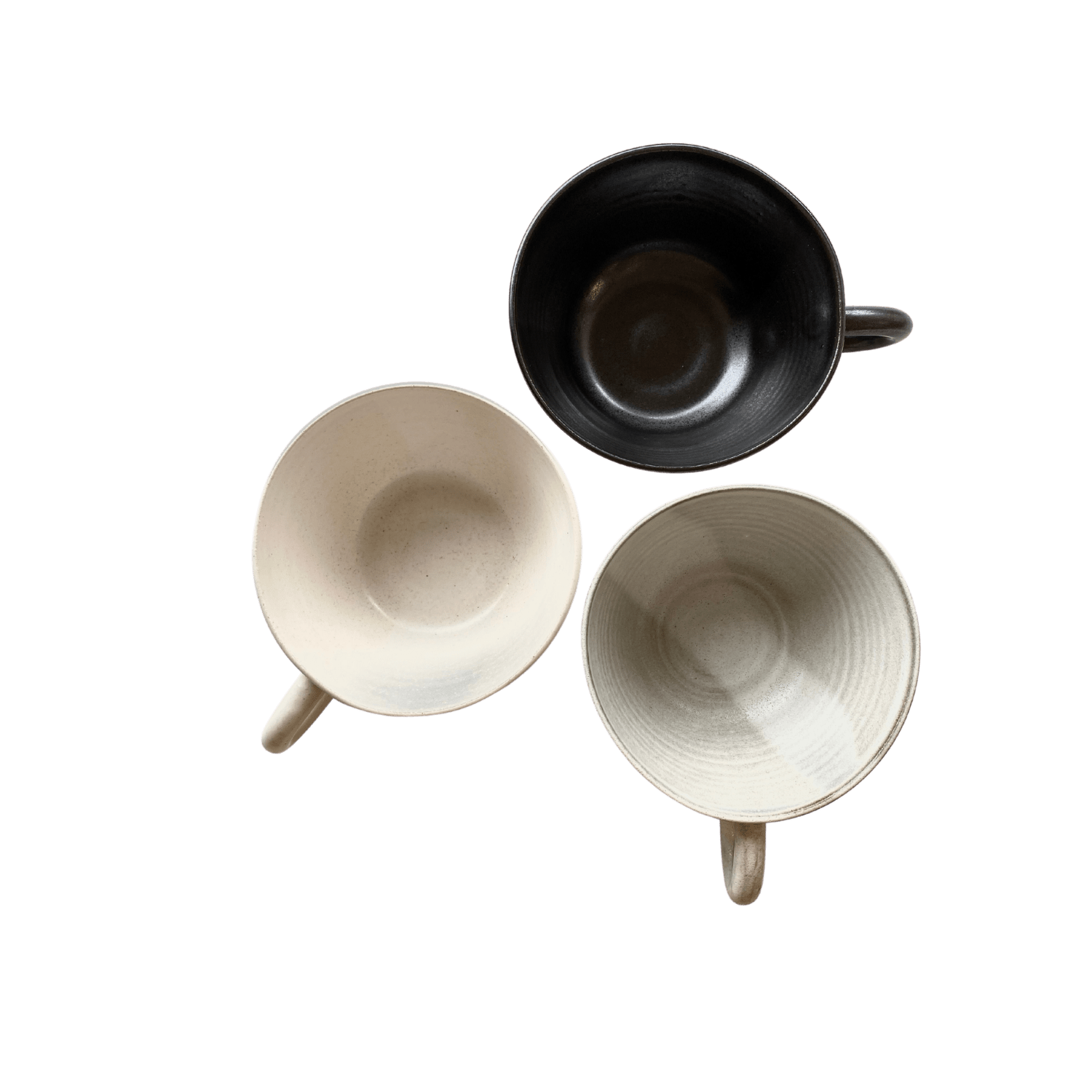
Mast Journal: So did you move into production pottery almost immediately after committing to a pottery career in 2008? How did that come about?
Eric: I had joined this studio that I’m still part of now. One of the potters there was doing production and was doing only wholesale, and looking at the way she was working, it seemed more interesting to do production pottery rather than doing one-of-a-kind pieces. Because one-of-a-kind is nice, but it doesn’t necessarily feed you unless you’re very, very well known. Also, I like to throw and sitting on my wheel makes me happy, so by doing production I was able to get paid and practice what I loved.
Mast Journal: I imagine production pottery can be very meditative since you’re doing the same process repeatedly. What are you thinking when you're at the wheel?
Eric: There are different stages. When you start the process of throwing, you have to concentrate on the shape. Since I’ve been doing it for awhile, it’s kind of muscle memory. My hands remember, and my body has to adjust to the piece that I’m going to throw. Once I’m adjusted, I can let my mind wander. I can look out the window and see a seagull and think, ‘Oh, it must be nice to fly around.’ Then I imagine what it must be like to be a bird. Or I listen to music or a podcast and think about how the world is falling apart [laughs]. So my mind can go in many directions. When you have to throw fifty cups, you just go.
Mast Journal: Speaking of music and podcasts, where do you find inspiration outside of the pottery world?
Eric: Basically, I don’t know anything about pottery. I don’t want to be inspired by other potters necessarily, and I don’t really look at pottery magazines too much. There are a few potters I follow on Instagram to be part of the community, but I try not to think about it in terms of inspiration. My inspiration is more in the architectural world, the furniture world, even fashion. I think the outside world is a full, inspirational land, and you can always get anything from anywhere. Sometimes you see a detail like bark on a tree, and that could influence you. At some point maybe I’ll come out with a bark collection. I don’t know!
Mast Journal: Is there anything in particular you look for when collaborating or partnering with others?
Eric: I can’t do too much since it’s a one man show and I do everything myself. There’s a limit to what I can do in a day, a week, a month, a year. So I always try to push myself, and it’s really hard to say no, but I do say no to a lot of people. I try not to work with too many people in the same area because then they’ll be competing with each other. I always work with one store in one town or one area. I try to be faithful to those people and keep my clients happy. If a partnership ends in one area, then I can take on a client in a similar area. It’s like when you bring something new into your house, something else has to go out to make room. The internet has really helped too because many people have found me there.
Mast Journal: Because pottery is a solo pursuit, how do you find community with other potters?
Eric: I’ve done a few retail shows which really helps to meet people. I think it can be inspiring sometimes just to talk about things, like a glaze problem, or chemical problem, and you can talk and get ideas and solutions. It’s also inspiring to meet people outside of pottery, just artists and creatives in general, because they too have chosen not to sell themselves to the corporate world and there’s a similar energy. It’s nice to be a part of that and to know that you might be a tiny island, but there are plenty of other islands around you.
Mast Journal: Do you ever wish that you could work with different materials?
Eric: Yes! A few years ago, I got this book about leatherwork and weaving leather. I was so into it – I bought the leather and studied the book, and two months later I was just like, ‘I’m never going to get this. Too complicated.’ So I thought, ‘I already spend all my time on pottery. What can I do that could make pottery look like leather?’ So I did a small line with leather and ceramics. I think it takes so much time and energy to become half-good at something, and I just don’t have enough lives. If I do something else next time, it’ll be weaving. I always liked textiles, and it could be something I could do at home when I’m old, so maybe that will be my next move.
Mast Journal
I’m really interested in artists’ routines and daily lives. Do you have a set routine, and what do you do if you’re feeling uninspired?
Eric: Well, it's one of the plusses of wholesale – you have orders and you have to fill them up. If I was doing one-of-a-kind pottery I think it would be more difficult. But I do have a routine. I get up, I exercise, I make breakfast, I usually ride a bike or take the subway to my studio. I’ll stop by a coffee place and have a five minute chat with the barista, and then I come to work and think about my day. I start, and usually I work through the entire day. Since I do everything myself, I’m always running out of time. Even having lunch, I’m standing and doing invoices or looking at emails. When you have your hand in the clay, it’s hard to do anything else. But yes, I have a very defined workday.
Mast Journal: Do you ever get lonely or do you embrace the individual nature of the work?
Eric: I always like to be by myself. I don’t get bored with myself. It might happen one day, but not yet! I sit down and I let my mind water, so I never get bored or lonely. Actually, sometimes I think, ‘Hmm, I should be a little more social.’ But it’s fine!
Mast Journal: What do you think is something people don’t know about pottery or might misunderstand about it?
Eric: Some people see a piece and they want it immediately. They want it practically the next day. I think it’s because we’re in the Amazon world. They want things right away, directly, delivered for free at their door. So to explain the process: first you have to shape the clay, then dry it, then trim it, fire it in the kiln for 24 hours, then it cools, and you glaze it again and refire it. So you have to pay attention at every step. If you rush one step, it won’t be a good piece. Also, people see a piece on the shelf and think that it’s easy, or simple to make.
Mast Journal: Right. Because pottery is accessible, and anyone can take a class and come home with a piece.
Eric: Yes. But when they actually take the class, I think most people realize that some are better than others. When you’re on the wheel, it’s clear that some people can make something more aesthetic. It’s not an art, but it’s a craft.
Mast Journal: So do you think some people have it naturally, and others don’t? Is that easy to tell?
Eric: Definitely. Having taught many people, from children to older adults, I could see when people had it and when they didn’t. When people have it, they can get really good, or they can kind of stay at a certain level. That’s when it comes down to practice.
Mast Journal: What’s your favorite part about what you do?
Eric: My favorite part of the whole process is throwing. I like to be on my wheel, have my hands in the clay, I like to see it transform from a ball of clay to a vessel. There’s an equilibrium between something totally soft and something that’s holding itself up. I think there’s something magical about it, and I’m always amazed that my two hands made these pieces. Also, it’s just fun. It has something very warm about it, like therapy or a blanket that you love to come back to. It’s comforting.
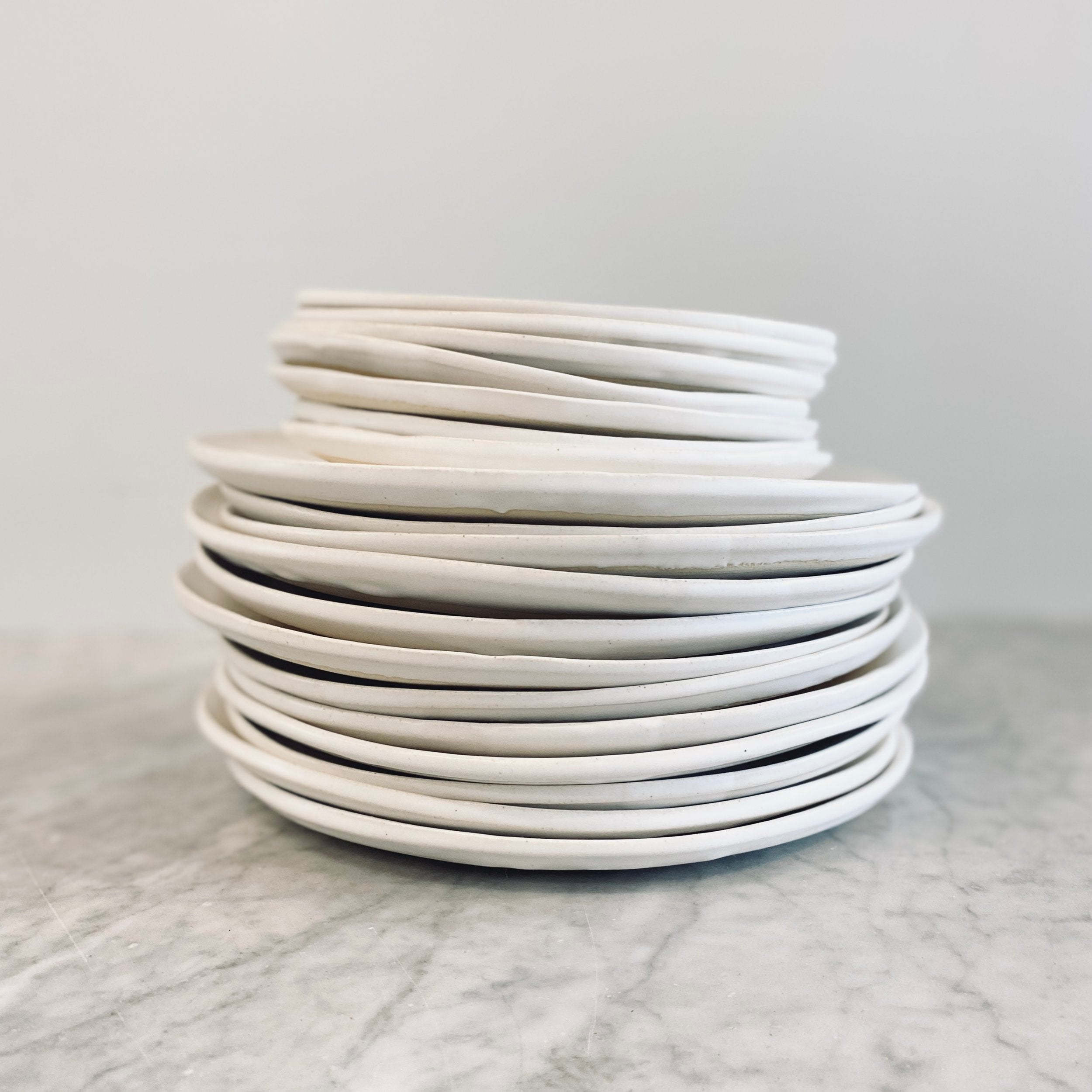
Dinner and salad plates in matte white, stacked.
Throughout Mast's lifetime, we have been fortunate enough to cross paths, form relationships, and forge bonds with countless craftspeople and inspiring individuals. We are grateful to count Eric Bonnin as one of them, and we look forward to seeing what he creates next.
The Mast Journal
